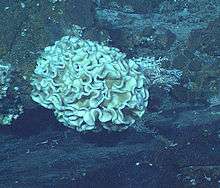Syringammina fragilissima
Syringammina fragilissima is a xenophyophore found off the coast of Scotland, near Rockall.[2] It is the largest single-celled organism known, at up to 20 centimetres (8 in) across.[3] It was first described in 1882 by the oceanographer John Murray, after being discovered on an expedition in the ship Triton which dredged the deep ocean bed off the west coast of Scotland in an effort to find organisms new to science. It was the first xenophyophore to be described and at first its relationship with other organisms was a mystery, but it is now considered to be a member of the Foraminifera.[4][5]
| Syringammina fragilissima | |
|---|---|
 | |
| Fig. 1. Syringammina fragilissima. Natural size, a, side view of a fragment representing about half an entire specimen; aa, original surface of specimen; b, ventral view of same specimen, showing uneven fractured surface near the middle of the test; dotted line shows approximately the original outline of the test. (After Brady) 2. Syringammina fragilissima. ×8. Portion of a radial section, showing at c one of the smaller secondary canals, and at cc one of the concentric reticulated partitions. (After Brady.) | |
| Scientific classification | |
| Clade: | SAR |
| Phylum: | Foraminifera |
| Class: | Monothalamea |
| Clade: | Xenophyophorea |
| Order: | Psamminida |
| Family: | Syringamminidae |
| Genus: | Syringammina |
| Species: | S. fragilissima |
| Binomial name | |
| Syringammina fragilissima | |
The organism appears as an agglomeration of sediment a few centimetres across, a sandy ball that easily crumbles when removed from the seabed. It consists of a single cell which expands to form hundreds of hollow branched and interconnecting tubes; these secrete an organic cement to which particles of sediment and sand adhere, forming a crusty structure called the test. As the test grows, the cell withdraws from parts of it, which are then colonised by other organisms, such as nematodes. The single cell has no cell divisions but is multinucleate, having multiple nuclei.[3]
It is not known how the organism feeds or reproduces. It may be a filter feeder, drawing water through the tubes and sifting out the nutritious particles. Alternatively, much faecal matter accumulates in the tubes, and it has been suggested that it feeds on the bacteria that colonise the waste. This theory is supported by the fact that it has high concentrations of lipids within its cytosol, which suggests that it may feed on bacteria from the sediment that makes up the tubes.[6] Another fact, the significance of which is not known, is that the organism has tiny crystals of barium sulphate scattered throughout the cytosol.[3]
References
- Brady, H. B. (1883). Note on Syringammina, a New Type of Arenaceous Rhizopoda. Proceedings of the Royal Society of London. 35(224-226): 155-161., available online at https://doi.org/10.1098/rspl.1883.0031
- "As large as life". New Scientist. 2157. October 24, 1998.
- Michael Marshall (February 3, 2010). "Zoologger: 'Living beach ball' is giant single cell". New Scientist.
- J. Alan Hughes & Andrew J. Gooday (2004). "Associations between living benthic foraminifera and dead tests of Syringammina fragilissima (Xenophyophorea) in the Darwin Mounds region (NE Atlantic)". Deep-Sea Research Part I: Oceanographic Research Papers. 51 (11): 1741–1758. Bibcode:2004DSRI...51.1741H. doi:10.1016/j.dsr.2004.06.004.
- Gooday, A.J; Aranda da Silva, A.; Pawlowski, J. (2011). "Xenophyophores (Rhizaria, Foraminifera) from the Nazare Canyon (Portuguese margin, NE Atlantic)". Deep-Sea Research Part II. 58 (23–24): 2401–2419. Bibcode:2011DSRII..58.2401G. doi:10.1016/j.dsr2.2011.04.005.
- Laureillard, J., L. Méjanelle, and M. Sibuet. "Use of Lipids to Study the Trophic Ecology of Deep-sea Xenophyophores." Marine Ecology Progress Series 270 (2004): 129-40. Print.
External links

- The Lost City 2005 Ocean Explorer, NOAA.